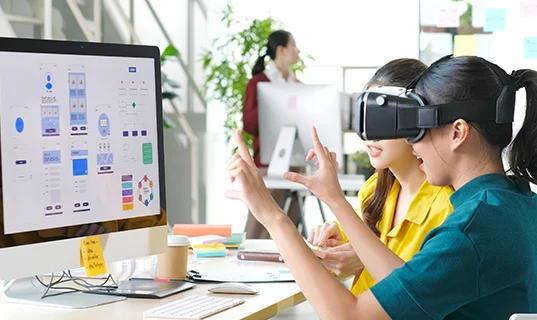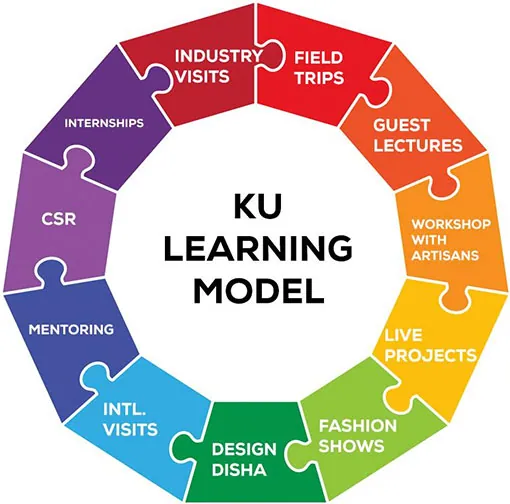B.Design (Hons.) Interaction Design (IxD) is a crucial interdisciplinary programme that aims to enhance the user experience by studying how people interact with various products, systems, and services. The department focuses on research and design to create seamless interactions that meet user needs and expectations. While Visual Communication and Product Design are essential in their own right, Interaction Design is primarily concerned with how users will interact with the visual elements, products, and services, relevant to the culture and demography.
Interaction Design encompasses a broad range of concepts and techniques, including UX (User Experience) design, UI (User Interface) design, Research Methodologies, voice and gesture-based interfaces, spatial interfaces, IoT systems, and Extended Reality (AR, VR) design. Ergonomics also plays a critical role in Interaction Design, ensuring that products and interfaces are comfortable and easy to use for users.
By focusing on the needs of the user and designing interfaces that are intuitive, efficient, and engaging, Interaction Design helps companies create products and services that are more effective, enjoyable, and profitable. Therefore, Interaction Design is an essential field for any organization that wants to remain competitive in today’s digital age.


KU CORE COURSES
PROGRAMME COMMON COURSES
KU CORE COURSES
PROGRAMME COMMON COURSES
PROGRAMME CORE COURSES
KU CORE COURSES
KU OPEN ELECTIVE- I
ELECTIVE COURSES
PROGRAMME COMMON COURSE
PROGRAMME CORE COURSES
KU OPEN ELECTIVE- II (Any one)
PROGRAMME COMMON COURSE
ELECTIVE COURSES
PROGRAMME CORE COURSES
KU CORE COURSES
PROGRAMME OPEN ELECTIVE- I (Any one)
ELECTIVE COURSES
PROGRAMME CORE COURSES
KU CORE COURSES
PROGRAMME ELECTIVE- II (Any one)
PROGRAMME COMMON COURSE
ELECTIVE COURSES
PROGRAMME CORE COURSES
PROGRAMME COMMON COURSE
PROGRAMME CORE COURSES
PROGRAMME CORE COURSES
PROGRAMME COMMON COURSE
 – UI/UX Design
– UI/UX Design  – Design Thinking & Design Research
– Design Thinking & Design Research  – Information Architecture
– Information Architecture  – Human Factors (Ergonomics)
– Human Factors (Ergonomics)  – Gamification
– Gamification  – Prototyping
– Prototyping  – Visual Design & Illustration
– Visual Design & Illustration  – B2B, B2C, Saas Applications
– B2B, B2C, Saas Applications  – Infographics
– Infographics The main objective of the course is to acquaint the students with practical knowledge regarding the conceptualization, design, and development of a new product. Interaction Designers have evolved from individual contributors to being called upon to reform business models, drive design standards across the organization, and improve the overall user experience. Interaction Design focuses on mobile/ web/ desktop applications, healthcare, finance, e-commerce, future tech, evolving technology-based design, etc. with an emphasis on the design of interface and behavior, user-centered design, experience design, and holistic product development. The course will give a high degree of design & tech knowledge balanced with creative ability and a hands-on approach. Students get well-acquainted with contemporary realities that are inclusive of sustainability and technological change. The student will gain the ability to use technology for the benefit of society.

The learning model at UID is incubated to create and adapt to an appropriate environment of learning that facilitates our students with new experiences. We make sure our learning model engages the learner into new dimensions of work. This model provides an environment for interactive student engagement and enhances the system thinking ability.
At UID, we believe that the experiential knowledge gained while developing and implementing this unique learning model is transferable to other disciplines as well.
Yes, you are eligible for B.Des. (Hons.) Interaction design, irrespective of your discipline. All you need is a curious mind!
Your portfolio should reflect your aesthetic and highlight your skills in 2D/ 3D sketching, problem-solving, the design process, and your ability to work hands-on. You may also include your extracurricular skills like photography, model making, presentation skills, etc. It is advisable to keep your portfolio concise & crisp.
Basic sketching skills will surely help you in the Design Aptitude Test. It is a good idea to practice sketching and doodling regularly as it helps you present your design ideas. Start exploring and enjoying different mediums of sketching. Product-specific drawings, digital renders, marker renders, and illustration techniques will be a part of your modules at UID.
The main purpose of interaction design is to create products that enable users to achieve their goals easily and in the best possible way, facilitating the interaction between humans and machines (or digital platforms) and making the services and systems offered more accessible.
Students at the Interaction Design programme at UID learn about all aspects when it comes to thorough User Experience, including Laws of Ux - a collection of best practices that designers can consider when building user interfaces. Some of them are - Fitts’s Law, Hick’s Law, Jacob’s Law, Miller’s Law, Occam’s Razor, Pareto Principle, Tesler’s Law, Von Restorff Effect, Zeigarnik Effect, Doherty Threshold, Serial Position Effect, etc.
Knowledge of coding or development is not required for admission; however, individuals should have basic knowledge of computer apps & HTML. Aspects of product development and processes will be touched upon during the modules taught.
The Interaction design programme at UID offers a well-balanced, hands-on, and industry-focused curriculum of theory and practical courses, taught over 4 years in an Undergraduate programme. The details of semester-wise subjects/courses are shared on the website in the department section.
The B.Des. (Hons.) Interaction Design includes subjects covering Design and Technology, User Experience Design, Laws of UX, Internet of Everything, UI Design, Universal Design, Interaction Detailing, Prototyping, Design Management, entrepreneurship, and research methodology. Students get the opportunity to study an International language as well as opt from a bouquet of Interdisciplinary electives. Internship & Graduation projects are offered to gain an understanding of the workings of the Interaction industry.
The form and content of a syllabus vary widely by discipline, department, course, and instructor. The curriculum of the Interaction Design programme is designed-validated-taught by faculties and experts from industry & academic backgrounds. Learning outcomes are core to the backward design process as the university designs & updates the curriculum periodically such that the learning outcome is contemporary to industry requirements.
Study trips are organized for students to sensitize them to the cultural influences that might affect the design of products. The trips may include visits to heritage places, Industry visits, design studios, industrial production units, etc. for an immersive experience as per the requirement of the courses. The trips may vary from local visits to outstation travels for a couple of days. Faculty members also accompany the students on the study trips.
Our students have pursued their internships with multinationals like IBM, Microsoft, Tata Elxsi, Godrej, Hettich, Titan, Capgemini, Amazon.com, Myntra, Accenture, Caratlane, HeadOut, and Byju’s. Students have also pitched their projects with various NGOs & governmental organizations among others.
The students upon completion of their degree choose one of the following,
The evaluation for each course has the following parts-
UID provides world-class facilities at its sprawling campus. The infrastructure includes a technologically advanced Felder Lab, a Makers Lab that includes 3D printers, an AR VR lab, machines for metal works, a fully functional wood workshop, a leather lab, a ceramic lab, audio-visual rooms, a library, an auditorium. All the classrooms are equipped with unique modern facilities and state-of-the-art equipment that provide an extensive experience in art and design. The campus also houses a Centre for Craft Innovation where students can engage in a symbiotic learning model with craftsmen & artisans from across the country for product development & diversification.
Classes are scheduled from 9 am to 4 pm on weekdays. Labs are kept open after hours at the request of students if required, safety precautions like masks, aprons, and gloves are all mandatory for the student’s safety.